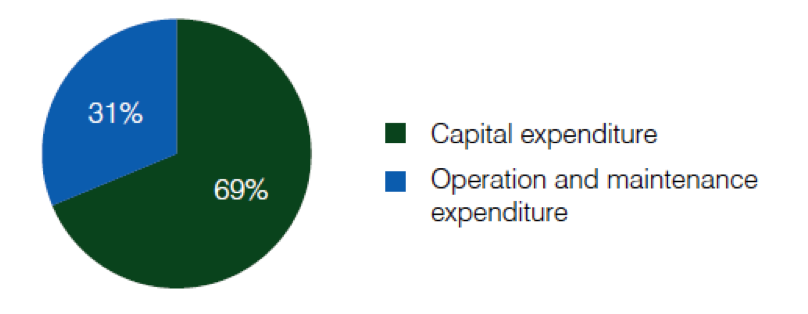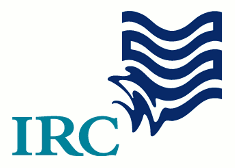Difference between revisions of "Capital Expenditure (CapEx)"
(→Capital expenditure sanitation service delivery) |
|||
| Line 8: | Line 8: | ||
<br> | <br> | ||
<br> | <br> | ||
| − | '''Figure 1 Capital Expenditure (CapEx)''' | + | '''Figure 1. Capital Expenditure (CapEx)''' |
{|style="color: white; background-color:#4682B4;" class="wikitable" | {|style="color: white; background-color:#4682B4;" class="wikitable" | ||
| Line 27: | Line 27: | ||
According to the 2012 GLAAS report (WHO and UN-Water, 2012, 29), 69% of funds for water and sanitation expended in 11 respondent countries were directed towards Capital Expenditure (see figure 2). | According to the 2012 GLAAS report (WHO and UN-Water, 2012, 29), 69% of funds for water and sanitation expended in 11 respondent countries were directed towards Capital Expenditure (see figure 2). | ||
| − | '''Figure 2 Capital expenditure versus operational and maintenance expenditure''' | + | '''Figure 2. Capital expenditure versus operational and maintenance expenditure''' |
[[Image:CapEx_OM.png|thumb|center|600px|Source: WHO and UN-Water, 2012, 29]] | [[Image:CapEx_OM.png|thumb|center|600px|Source: WHO and UN-Water, 2012, 29]] | ||
| Line 33: | Line 33: | ||
Based on research from the [[#WASHCost]] project, Capital Expenditure (CapEx) to provide a basic level of water service with a borehole and handpump (at 2011 prices) range from US$ 20 per person to just over US$ 60 per person (see figure 3). For small schemes, including mechanised boreholes and piped supplies, the costs range from US$ 30 to just over US$ 130 per person. For intermediate and larger schemes benchmark capital costs vary widely from US$ 20 to US$ 152 per person. | Based on research from the [[#WASHCost]] project, Capital Expenditure (CapEx) to provide a basic level of water service with a borehole and handpump (at 2011 prices) range from US$ 20 per person to just over US$ 60 per person (see figure 3). For small schemes, including mechanised boreholes and piped supplies, the costs range from US$ 30 to just over US$ 130 per person. For intermediate and larger schemes benchmark capital costs vary widely from US$ 20 to US$ 152 per person. | ||
| − | '''Figure 3 Total Capital Expenditure per person for borehole and handpump, small schemes and intermediate to large schemes required for a basic level of service''' | + | '''Figure 3. Total Capital Expenditure per person for borehole and handpump, small schemes and intermediate to large schemes required for a basic level of service''' |
{|style="color: white; background-color:#4682B4;" class="wikitable" | {|style="color: white; background-color:#4682B4;" class="wikitable" | ||
|Cost component | |Cost component | ||
Revision as of 04:32, 12 December 2012
|
Capital Expenditure is the costs of providing a water or sanitation service to users where there was no service before; or of substantially increasing the level of services received by users. It includes the capital invested in first time construction or purchase of fixed assets such as concrete structures, wells, pumps, pipes or toilets prior to implementation of the service and to improve or expand existing water or sanitation systems. Costs for rehabilitation or replacement of major parts of a water or sanitation system, such as replacing a pump, are considered expenditure on capital maintenance (CapManEx). Capital expenditure (CapEx) consists of expenses on hardware and software (see figure 1). Capital expenditure hardware (CapEx hrd) includes expenditure on fixed assets as pumps, pipes, etc. and required equipment such as vehicles or offices to support the construction of water and sanitation systems prior to implementation of the service. Capital Expenditure software (CapEx Sft) includes the costs of one-off work with stakeholders prior to construction or implementation or extension of the service such as one-off training of pump mechanics or caretakers, community mobilisation or hygiene education.
Source: Smits et.al, 2011, 7.
ContentsExamplesAccording to the 2012 GLAAS report (WHO and UN-Water, 2012, 29), 69% of funds for water and sanitation expended in 11 respondent countries were directed towards Capital Expenditure (see figure 2). Figure 2. Capital expenditure versus operational and maintenance expenditure Capital expenditure water service deliveryBased on research from the #WASHCost project, Capital Expenditure (CapEx) to provide a basic level of water service with a borehole and handpump (at 2011 prices) range from US$ 20 per person to just over US$ 60 per person (see figure 3). For small schemes, including mechanised boreholes and piped supplies, the costs range from US$ 30 to just over US$ 130 per person. For intermediate and larger schemes benchmark capital costs vary widely from US$ 20 to US$ 152 per person. Figure 3. Total Capital Expenditure per person for borehole and handpump, small schemes and intermediate to large schemes required for a basic level of service
Source: IRC, 2012a, 1. The costs as shown in figure 3 (above) are based on the provision of a basic level of water service, as defined by WASHCost, it implies that the following criteria have been realised by the majority of the population in the service area: People access a minimum of 20 litres per person per day, of acceptable quality (judged by user perception and country standards) from an improved source which functions at least 350 days a year without a serious breakdown, spending no more than 30 minutes per day per round trip (including waiting time). Capital expenditure sanitation service deliveryBased on research from the #WASHCost project, the minimum Capital Expenditure required to provide a basic level of sanitation service ranges from US$ 7 for a basic pit latrine to US$ 36 (2011 prices) for a Ventilated Pit Latrine (VIP) (see figure 4). Figure 4. Total Capital Expenditure per facility for traditional pit latrines, pit latrines pour- flush or septic tank required for a basic level of service
Key Documents and References
In partnership with IRC and the Rainwater Harvesting Implementation Network, WASHCost studied the historical trends and drivers of adopting Rain Water Harvesting (RWH). Detailed comparisons are made between life-cycle costs of RWH systems and the life-cycle costs of other water supply systems.
This briefing note presents an application of the life-cycle costs (LCCA) approach to sanitation in rural and peri-urban areas in four different countries— Andhra Pradesh (India), Burkina Faso, Ghana, and Mozambique. The document compares the differences between the financial costs of traditional and improved latrines, and the quality of service delivered to users.
This briefing note describes the life-cycle costs approach and why it was developed. It explains the main cost components for water and sanitation in rural and peri-urban areas.
Information sheet provides an overview of the minimum benchmarks for costing sustainable basic services in developing countries. The benchmarks have been derived from the WASHCost project dataset and the best available cost data from other organisations all over the world. The benchmarks are useful for planning, assessing sustainability from a cost perspective and for monitoring value for money.
Links
|
| ||||||||||||||||||||||||||||||||||||||||||||||||||||||||


